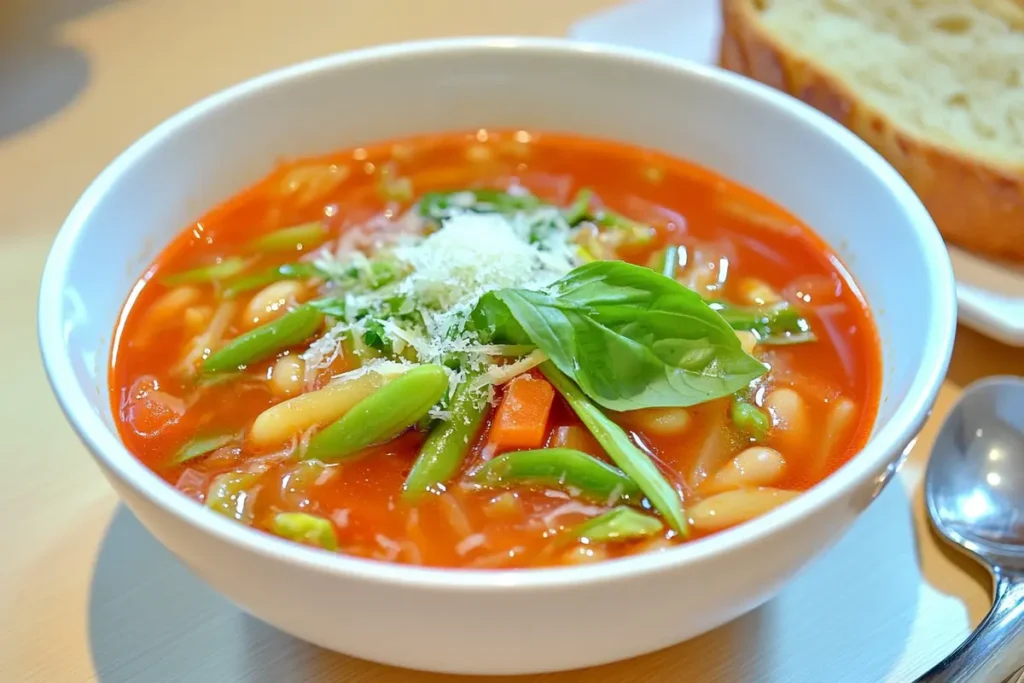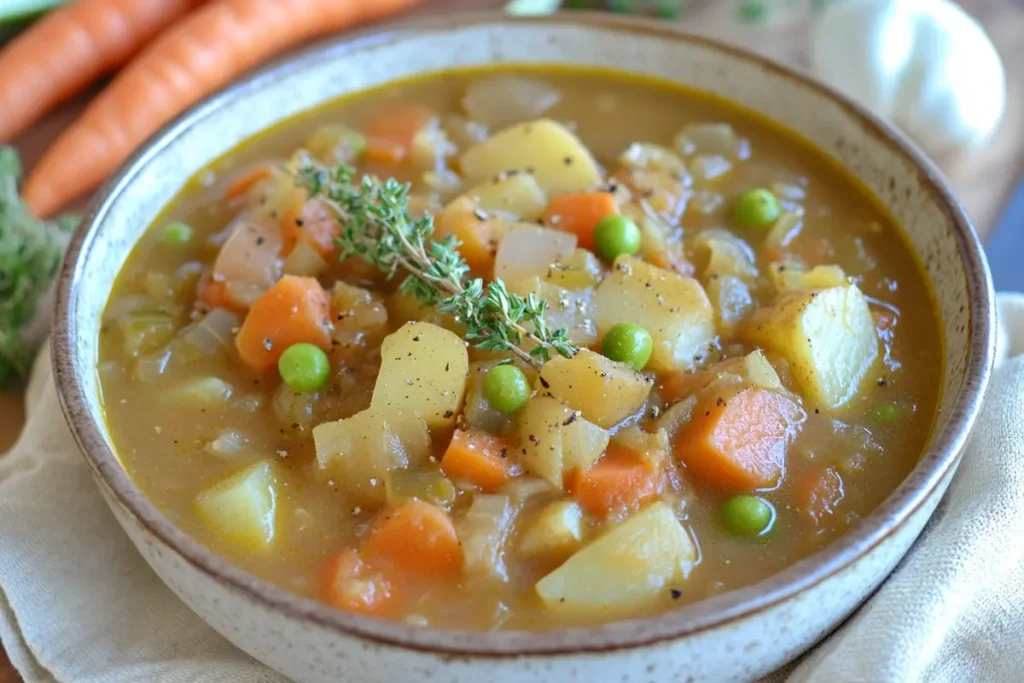Soups are a staple comfort food, enjoyed worldwide for their versatility and warmth. Two popular soup varieties often debated are minestrone soup and vegetable soup. While they may appear similar at first glance, they have distinct characteristics that set them apart. In this article, we’ll dive deep into the key differences between these two soups, exploring their origins, ingredients, preparation methods, and cultural significance.
Introduction to Minestrone and Vegetable Soup
If you’ve ever wondered “What is the difference between minestrone and vegetable soup?”, you’re not alone. Both soups are vegetable-rich, hearty, and nourishing, making them popular choices in homes and restaurants. However, their origins and specific preparation styles give each its unique identity.
Minestrone is a traditional Italian soup with a history rooted in rustic, seasonal cooking. It’s characterized by its thick texture and inclusion of pasta or rice. On the other hand, vegetable soup is a broader category that encompasses countless regional variations, typically featuring a lighter broth and a wide range of vegetables.
What Is Minestrone Soup?

Minestrone soup is an iconic Italian dish that reflects the country’s agricultural richness and culinary heritage. Let’s explore its key elements.
1. Origins and Cultural Background
Minestrone dates back to ancient Rome, where it was originally a simple dish made with seasonal vegetables, legumes, and grains. Over time, it evolved to include ingredients like tomatoes, beans, and pasta, becoming a hearty meal in itself.
In Italian households, minestrone is often a way to use leftover vegetables, making it a sustainable and flexible dish. Its name comes from the Italian word “minestra,” meaning “soup.”
2. Key Ingredients in Minestrone
Minestrone is defined by its use of vegetables, legumes, and grains. Common ingredients include:
- Vegetables: Carrots, celery, zucchini, tomatoes, and onions.
- Legumes: Cannellini beans or kidney beans are typical.
- Pasta or Rice: Small pasta shapes like ditalini or rice, such as Arborio, are often added for heartiness.
- Broth: Minestrone is cooked in a vegetable or chicken broth, often thickened by the starches from pasta or beans.
- Herbs: Basil, oregano, and parsley are frequently used for flavor.
The result is a rich, hearty soup that’s a complete meal.
3. Preparation Method
Minestrone is prepared in layers:
- Start by sautéing aromatics like onions, garlic, and celery in olive oil.
- Add harder vegetables, such as carrots and zucchini, followed by softer ones like tomatoes.
- Incorporate legumes, broth, and herbs.
- Simmer until the vegetables are tender.
- Cook pasta or rice directly in the soup or separately, and stir in before serving.
The dish is often garnished with grated Parmesan cheese or a drizzle of olive oil.
What Is Vegetable Soup?

Vegetable soup is a more generic term that refers to soups made primarily with vegetables. It’s a versatile dish found in nearly every cuisine around the world.
1. Origins and Cultural Background
Unlike minestrone, vegetable soup doesn’t have a single origin. It’s a universal dish that varies greatly depending on regional ingredients and traditions. In some cultures, vegetable soup is a light appetizer, while in others, it’s a filling main course.
2. Key Ingredients in Vegetable Soup
Vegetable soup typically includes:
- Vegetables: A variety of seasonal or regional vegetables such as potatoes, cabbage, spinach, or leeks.
- Broth: Usually a clear vegetable or chicken stock.
- Herbs and Spices: Thyme, bay leaves, or dill might be used to enhance the flavor.
- Optional Add-Ins: Some variations may include meat, noodles, or grains.
Unlike minestrone, vegetable soup doesn’t rely on specific ingredients, making it a more adaptable dish.
3. Preparation Method
The preparation of vegetable soup is straightforward:
- Chop and sauté vegetables in a pot with a bit of oil or butter.
- Add broth and seasonings.
- Simmer until the vegetables are tender.
- Optional: Blend part of the soup for a creamier texture or keep it entirely chunky.
This simplicity allows for infinite variations.
Comparing Minestrone and Vegetable Soup
1. Ingredients
- Minestrone: Always includes beans and pasta or rice, making it heartier. It also uses Italian herbs like oregano and basil.
- Vegetable Soup: Focuses solely on vegetables and offers more flexibility in ingredient choice. Grains or pasta are optional.
2. Texture
- Minestrone: Thick and chunky, thanks to the addition of pasta, beans, and starchy vegetables.
- Vegetable Soup: Can range from brothy and light to creamy, depending on the preparation.
3. Broth
- Minestrone: Typically uses a richer, tomato-based broth.
- Vegetable Soup: Often features a clear broth, unless puréed or thickened.
4. Cultural Context
- Minestrone: A dish with strong Italian roots, carrying a cultural and historical significance.
- Vegetable Soup: A more generic term that applies to countless global variations.
5. Serving Style
- Minestrone: Served as a main course, often with bread or grated Parmesan.
- Vegetable Soup: More commonly an appetizer or side dish, though it can also be a main course.
Nutritional Comparison
1. Calories and Macronutrients
- Minestrone: Higher in calories and carbohydrates due to the inclusion of pasta or rice.
- Vegetable Soup: Lower in calories and carbs, especially if it’s broth-based.
2. Fiber and Vitamins
Both soups are rich in fiber and vitamins, thanks to the abundance of vegetables. Minestrone has the added benefit of legumes for extra protein and fiber.
3. Fat Content
- Minestrone: May contain slightly more fat if cheese or olive oil is added.
- Vegetable Soup: Generally lighter, with minimal fat unless butter or cream is used.
Variations Around the World
Both minestrone and vegetable soup have inspired countless regional adaptations:
- Italian Minestrone: The classic version with pasta, beans, and a tomato-based broth.
- French Potage: A creamy vegetable soup that’s often puréed.
- Chinese Vegetable Soup: Features bok choy, mushrooms, and a light broth flavored with soy sauce.
- Mexican Sopa de Verduras: A vegetable soup spiced with cumin and chili.
- American Vegetable Soup: Often includes corn, green beans, and potatoes.
FAQs About Minestrone and Vegetable Soup
1. Can Minestrone Be Considered a Vegetable Soup?
Yes, minestrone is a type of vegetable soup but with specific characteristics like pasta or beans and a thicker texture.
2. Can You Make Minestrone Without Pasta?
Absolutely! While pasta is a defining ingredient, you can replace it with rice, quinoa, or skip it altogether for a lighter version.
3. Is Minestrone Healthier Than Vegetable Soup?
It depends on the recipe. Minestrone is heartier and higher in calories, while vegetable soup is typically lighter and lower in carbs.
4. What’s the Best Way to Store These Soups?
Both soups can be stored in an airtight container in the refrigerator for up to 3 days. Minestrone may thicken as it sits, so add broth when reheating.
5. Can I Freeze Minestrone and Vegetable Soup?
Yes! Both soups freeze well. However, for minestrone, consider cooking the pasta separately to prevent it from becoming mushy when reheated.
Conclusion
Now that you know what is the difference between minestrone and vegetable soup, you can appreciate the unique qualities of each dish. Minestrone is a hearty, Italian classic with a rich history and distinct ingredients, while vegetable soup is a versatile, global favorite that can be tailored to any palate. Whether you’re craving a comforting meal or a light starter, there’s a version of these soups to suit your taste.